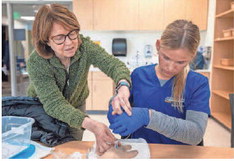New Tool will get Nurses, others into Workforce Faster
Kelly Meyerhofer
Milwaukee Journal Sentinel | USA TODAY NETWORK – WISCONSIN
A new tool is speeding up the process for nurses, physical therapists and others in health care fields to receive their state licenses, allowing them to join the workforce faster.
The improvements by the state Department of Safety and Professional Services come after years of scrutiny for the beleaguered agency, which struggled with application backlogs during COVID-19 because of outdated systems, staffing shortages and an increase in health care workers seeking temporary licenses.
The agency piloted a technology platform for li- censing applications with several nursing schools this year, including the University of Wisconsin-Milwau- kee, Marquette University, Milwaukee Area Technical College, Fox Valley Technical College, Mid-State Tech- nical College and Marian University in Fond du Lac.
Critics of Democratic Gov. Tony Evers seized on the delays during last year’s election as nurses and others on the front lines waited months to start working be- cause their licenses were hung up in the paper-driven processing system.

Clinical instructor Katie Fitzpatrick, left, helps nursing student Kayla Heinze practice starting an IV line in a mannequin arm in the clinical simulation center in February in the Northwest Quadrant building at UW-Milwaukee. A new tool is speeding up the process for nurses, physical therapists and others in health care fields to receive their state licenses. MARK HOFFMAN/MILWAUKEE JOURNAL SENTINEL
The early results for UW-Milwaukee are promising, said UWM College of Health Professions and Sciences Dean Kim Litwack. A little more than half of nursing graduates last May had their license issued before the end of June. All but 15 students had their license by the end of July. Previously, the average time for a UWM health sciences student to obtain a license was about three months, according to university data.
“We really saw that the process sped up licensure, and we’re very optimistic that it will continue to do so and bring these individuals into the workforce right away,” Litwack said at a Nov. 14 campus event.
About 900 students in the college apply for licenses annually, including registered nurses, occupational therapists, audiologists, and speech-language pathologists.
Another improvement: Colleges and universities are better incorporated into the licensing process. Schools now have their own log-in to the platform so academic advisers can, in real-time, monitor the progress of their students’ applications and assist when students hit a snag. Staff can also provide statements of graduation verification for an entire batch of students as opposed to the previously painstaking process of manually uploading documents one by one.
“It saves the schools time, it saves the department time and it saves the students and employers time,” department secretary Dan Hereth said.
The agency’s goal is to have the tool in place at all UW institutions, technical colleges and private uni- versities for most all health care professions by commencement time this coming spring.
The $106,500 cost of the platform was paid for with federal COVID-19 relief money, said agency spokesper- son John Beard. Annual costs to maintain it will be paid through fees.
The new tool comes on top of the department’s new public dashboard unveiled earlier this year. It shows application review times by profession, along with other data.
